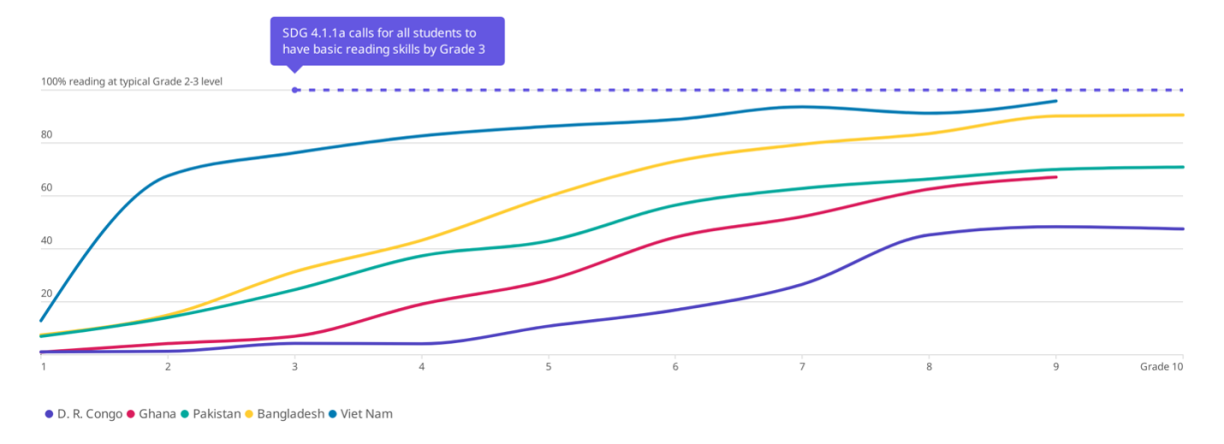Learning trajectories
Learning trajectories show the skills children gain over time and offer insights into which policy priorities can help address the learning crisis.
What are learning trajectories?
Learning trajectories (also referred to as learning profiles) show how much children learn over time in a particular context. Where most efforts to measure learning focus on what children know at one point in time, usually through an assessment late in the schooling cycle, learning trajectories trace out the process of learning as children progress through school.
Learning trajectories from five low- and lower-middle income countries showing how quickly children are learning foundational reading skills

Source: GEM Report SCOPE website based on analysis of UNICEF MICS6 data as described in Kaffenberger and Silberstein (2022)
What can learning trajectories tell us?
Learning trajectories can help us better understand and visualise the learning crisis.
They can also simulate the potential impact of different policies on learning and help inform what education systems should prioritise to address the learning crisis.
This video (summarised in the bullet points below) presents some of the most important and consistent messages that emerge from research on learning trajectories:
- The learning crisis is worse than we think it is. Learning trajectories are too flat, meaning that students learn little during each year they spend in school. Far too many students in developing countries will not acquire foundational literacy and numeracy by the time they finish primary or even lower secondary school, and most countries will fall far short of the Sustainable Development Goals (SDG) for learning.
- Children fall behind early and then tend to stay behind, highlighting the need for early intervention that ensures all children master foundational skills. This is visible in learning trajectories that flatten out early and never recover. These trajectories illustrate the cumulative nature of learning: foundational literacy and numeracy are the gateway to higher level skills, and they can set a country (or individual child) on a steeper overall learning trajectory. You can’t fix Grade 9 in Grade 8; improvements are needed in the early primary years to enable later learning.
- Policy simulations using learning trajectories show that expanding access to schooling will not, on its own, address the learning crisis in most countries. Learning trajectories link schooling and learning, and so are well-suited to modelling how much additional learning we could expect if every child enrolled and stayed in school. Because children learn relatively little each year in school, spending more years there will not improve learning by very much. Instead, it is necessary to increase the pace of learning per year. (However, the results of these simulations vary according to context. There is a need to analyse learning trajectories at a national and sub-national level to determine the uncommon instances where improving access to schooling could be expected to also deliver on learning.)
- Policy simulations also show that achieving parity between advantaged and disadvantaged groups within countries will not, on its own, be enough to address the learning crisis. Learning trajectories are also a useful tool to simulate the consequences of policies focused on closing in-country gaps between groups. For example, what if girls received just as much schooling as boys and learned just as much during their years in school? Even if countries achieved parity between boys and girls, rich and poor, and urban and rural areas, most children would still not gain foundational skills and reach the SDG learning targets (although some countries would benefit more than others). This is because learning levels are low across entire education systems such that even the advantaged are not doing that well. This points to the need to focus on absolute rather than relative learning outcomes and to prioritise changes that shift the entire education system toward producing more learning for the advantaged and disadvantaged alike.
- Learning trajectories vary dramatically across countries, within countries, and even within classrooms. The variation in how much and when children learn points to the critical importance of aligning the level of instruction with children’s learning levels, either by reorienting curricula to match the rate at which children learn, or through changes to other components of instruction (e.g., teaching materials and assessments).
Key resources
Interactive online tool to understand, build, and analyse learning trajectories for 30+ countries
This one-stop-shop webpage for learning trajectories, created in partnership with the Global Education Monitoring Report, allows users to explore key policy messages through interactive data visualisations, build and analyse their own learning trajectories, and run their own policy simulations for more than 30 countries.
Researchers interested in the underlying dataset (UNICEF’s MICS6 survey on foundational learning) can also access the raw data, cleaned data, and code.
Data visualisations to model COVID-19-related learning loss and mitigation strategies
This set of visualisations uses learning trajectories to illustrate the potential long-term consequences of COVID-19 school closures on learning. It also allows education leaders to estimate how different strategies might help recover lost learning.
Research
An overview of the types of analysis and insights that learning trajectories offer can be found in two RISE Insight Notes: Kaffenberger (2019) and Silberstein (2021).
A more in-depth review of learning trajectories is a RISE-led Special Issue of the International Journal of Educational Development (IJED). This Special Issue collects 12 open-access papers that explore what learning trajectories can tell us about how to address the global learning crisis. These papers analyse learning trajectories in more than 50 countries, based on assessments of more than 6 million individuals, using multiple data sources and measures of learning.
For more, see our comprehensive list of RISE research outputs on learning trajectories.
